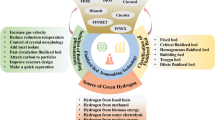Abstract
Recycling iron-bearing solid wastes generated during iron and steelmaking processes is crucial for optimizing resource utilization and mitigating carbon emissions. The Rotary Hearth Furnace (RHF) has emerged as a promising alternative for sponge iron production from solid waste. This study developed a 3D computational fluid dynamics (CFD) model of a pilot-scale RHF using the FLUENT solver to investigate use of hydrogen as a fuel. The results indicated that substituting hydrogen for hydrocarbon-based fuels led to a remarkable reduction in fuel and air consumption, resulting in increased profitability for direct reduced iron (DRI) production. Optimum conditions for post-combustion of CO, air, and fuel rate and their preheat temperature were identified to minimize fuel rate and emission, maximizing heat transfer to pellet bed, and maintaining a reducing atmosphere over pellet bed to restrict reoxidation of metalized pellet with hydrogen as heat-producing fuel.








Similar content being viewed by others
Abbreviations
- A, B :
-
Constant in the eddy-dissipation model
- C1 ε, C 2 ε , C 3 ε ,C μ :
-
Constants in standard k—ε model
- C p :
-
Specific heat at constant pressure
- D i ,m :
-
Diffusion coefficient for species i in the mixture
- E :
-
Total energy per unit mass
- E a :
-
Activation energy
- G k :
-
Production of turbulent kinetic energy by buoyancy
- G t :
-
Production of turbulent kinetic energy by velocity gradient
- g j :
-
Component of gravitational vector in the jth direction
- k:
-
Turbulent kinetic energy
- p:
-
Pressure
- Prt :
-
Turbulent Prandtl number
- R :
-
Universal gas constant
- r:
-
Distance of a point from the centre of the pellet
- S chem :
-
Source term of heat of chemical reaction
- S rad :
-
Source term for heat of radiation
- Sct :
-
Turbulent Schmidt number
- T :
-
Temperature
- t:
-
Time
- u i :
-
Velocity component
- Yi:
-
Mass fraction of species i
- β :
-
Coefficient of thermal expansion
- δ ij :
-
Kronecker delta
- ε :
-
Dissipation rate of turbulent kinetic energy per unit mass
- μ :
-
Molecular viscosity
- μ e ff :
-
Effective viscosity
- μ t :
-
Turbulent viscosity
- v i, r :
-
Stoichiometric coefficient for reactant i in reaction r
- \(v_{{{\text{i}},{\text{r}}}}^{\prime \prime }\) :
-
Stoichiometric coefficient for product i in reaction r
- p:
-
Density
- σ :
-
Stefan-Boltzmann constant
- σ k :
-
Turbulent Prandtl number for k in standard k—ε model
- σ ε :
-
Turbulent Prandtl number for ε in standard k—ε model
- R total :
-
Total thermal resistance
- q’’:
-
Total heat flux
- h r :
-
Heat transfer coefficient for radiation
- h c :
-
Heat transfer coefficient for convection
- d ref :
-
Thickness of refractory wall
- d shell :
-
Thickness of shell
- k ref :
-
Thermal conductivity of refractory
- k shell :
-
Thermal conductivity of shell
- k c :
-
Thermal conductivity of air
- T r :
-
Inside wall temperature of furnace
- T w :
-
Outside shell temperature
- T atm :
-
Ambient temperature
- Nu:
-
Nusselt number
- Ra:
-
Rayleigh number
- Pr:
-
Prandlt number
- Gr:
-
Grashof number
- L c :
-
Characteristic length
- ∆H r :
-
Net heat effects of reaction r
- q R :
-
Radiative heat transfer rate per unit area in the non-transparent gas
References
Sen P K, and Roy G G, Trans Indian Inst Met 75 (2022) 2453.
Ishikawa H, Kopfle J, Mcclelland J, and Ripke J, Arch Metall Mater 53 (2008) 541.
Wu Y L, Jiang Z Y, Zhang X X, Wang P, and She X F, Int J Miner Metall Mater 20 (2013) 636.
Liu Y, Su F Y, Wen Z, Li Z, Yong H Q, and Feng X H, Metall Mater Trans B 45 (2014) 251.
Liu Y, Wen Z, Lou G, Li Z, Yong H, and Feng X, Metall Mater Trans B 45 (2014) 2370.
Saleem S, and Roy G G, Ironmak Steelmak 48 (2021) 229.
Saleem S, and Roy G G, Metall Mater Trans B 51 (2020) 2735.
Biswas A K, Principles of Blast Furnace Ironmaking, SBA Publications, Calcutta, India (1981), p 6.
FLUENT 2021R2 User’s Guide, Fluent Inc., Southpointe (2021).
Bureau of Energy Efficiency, Furnaces. https://beeindia.gov.in/sites/default/files/2Ch4.pdf. Accessed 4 Nov 2022.
Touloukian Y S, Specif Heat Met Elem Alloys 4 (1966) 8–47.
Author information
Authors and Affiliations
Corresponding author
Additional information
Publisher's Note
Springer Nature remains neutral with regard to jurisdictional claims in published maps and institutional affiliations.
Rights and permissions
Springer Nature or its licensor (e.g. a society or other partner) holds exclusive rights to this article under a publishing agreement with the author(s) or other rightsholder(s); author self-archiving of the accepted manuscript version of this article is solely governed by the terms of such publishing agreement and applicable law.
About this article
Cite this article
Tank, S., Saleem, S. & Roy, G.G. Low Emission Sponge Iron Production in RHF: A CFD Study. Trans Indian Inst Met (2023). https://doi.org/10.1007/s12666-023-03036-7
Received:
Accepted:
Published:
DOI: https://doi.org/10.1007/s12666-023-03036-7




